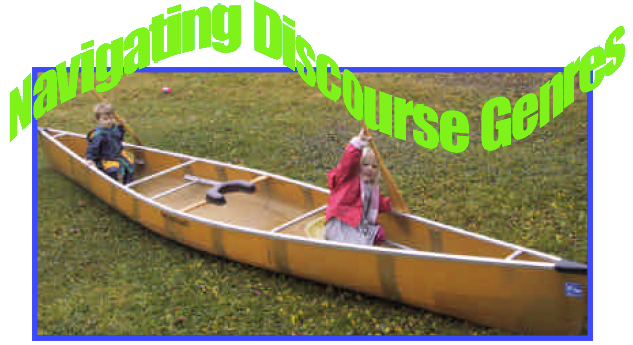
Parallel Texts in American Sign Language and English
on Canoeing in the Boundary Waters
with Eric Larson and Jenny Stenner
Interpretations by Anthony Verdeja
Strategies for Practice
There are many possibilities for working with these texts. It is hoped that what is suggested here will lead you to discover other ways of becoming more familiar with discourse genres and the impact that they can have on our interpreting work.
1. Practice prediction skills
Based on your knowledge that the text is about “Canoeing in the BWCA” and fits into a certain genre, predict different possibilities for what the text might be about and what language features it might contain. For example, predict what you might expect as differences between a text that is argumentative in nature and one that is a narrative.
2. Do comparative/contrastive discourse analysis
Using the sheet on the next page as a framework for analysis, watch one of the texts. Analyze what features are present within that text and try to figure out what function they carry out within that genre. Then, assess what would features in the target language would carry out the same feature. After watching a text in one language, watch the text in the other language and see what similarities and differences you note. On each page, there are starter questions to get you going. These are only suggestions, and it is hoped that they will start you on a path towards deeper analysis.
You can also compare texts within the same language that are of different genres. For instance, try watching the Narrative and procedural texts in ASL. See what different features exist between these two texts, even though they are the same signer communicating in the same register.
3. Practice interpreting texts within specific genres
Using the narratives as an example, practice interpreting from English to ASL. Videotape your interpretation. Watch your ASL interpretation and note what linguistic features are included in the interpretation. Then watch the ASL narrative and compare the features that are in your interpretation. After making that comparison with a native signer, try interpreting the English text again and see if you note any differences between your first and second interpretations. This process can also be used for interpreting from ASL to English as well and working with any of the genres.
4. Analyze the interpretations
Given the resources in this project, as well as the other suggested resources, analyze the interpretations to see how effectively they convey the different features of the genre. You can use the text in the other language as an example of some of the things we might expect to find in the target language. You can also use the transcripts or outlines of the source texts to help analyze the interpretation and to detect the ways that the interpreter manages the process of interpreting from a source that he is not able to interrupt or ask for clarification.
